AI tools are invaluable for marketing as they improve efficiency and productivity, but it takes practice to communicate with them effectively. Think of talking to AI tools like ChatGPT as talking to a very literal person — you need to spell things out for the best results.
Thankfully, we've been practising our communication skills here at Avidly and have discovered that achieving desirable outcomes comes down to mastering AI prompt building. There’s an art of crafting prompts that enable our robot friends to understand and respond to human language.
In this article, we'll explore the basics of AI prompt building, introduce you to our tried and tested prompt-building framework and show you how different roles in marketing can utilise effective prompt-building to increase efficiency.
- What are AI prompts?
- What is AI prompt building?
- Our AI prompt-building framework
- AI prompts in different marketing roles
What are AI prompts?
AI prompts are our way of telling AI tools what we want and how we want it. Think of it as a command or instruction.

You can use AI prompts to produce text or images. To produce an image from an AI prompt, you prompt the tool with what you would like the image to look like. Let’s try it on a popular AI image processing system called DALL-E 2.

As you can see, both prompts produced the results that I asked for. However, these were fairly simple requests. Real communication skills come into play when looking for more specific results — this is when you have to master AI prompt building.
What is AI prompt building?
AI prompt building is tweaking the prompts you give AI to produce the best results. Knowing how to do this is important to achieve the results you want. If you continue to give unclear prompts, you’ll end up frustrated.
Our Head of Strategy (AKA Chief Prompting Officer), Josh Quarrie, said it best:
“The quality of output you get from AI depends on the quality of input you provide.”
Let's look at this cheese commercial for a second.
A young boy is asked by his mother to pick up gouda from a local cheese shop. But, when the boy arrives, he stuffs his mouth with cheese samples and tells the employee what he'd like with a full mouth. The employee doesn't understand what he says because his mouth was full of cheese, so he brings home havarti instead of gouda.
The boy gives an unclear prompt to the employee, so, in return, he receives a less-than-desired result.
Thankfully, we've built the perfect framework to help you create prompts that give you the best results. So enough about cheese. Let’s get into crafting some serious results-driven prompts!
Our AI prompt framework
When creating great AI prompts, there are three things you want to provide in this order:
- Setting — Sets the tone or context
- Instruction — What you want it to do
- Data — Source data or examples
Here’s a well-thought-out prompt:
Imagine you're a full-time content writer working at a digital marketing agency — this is the setting. Write three blog post ideas on the topic of choosing your next luxury getaway — this is the instruction. Place an emphasis on weather, food and people — this is the data.
Let’s see how this plays out.
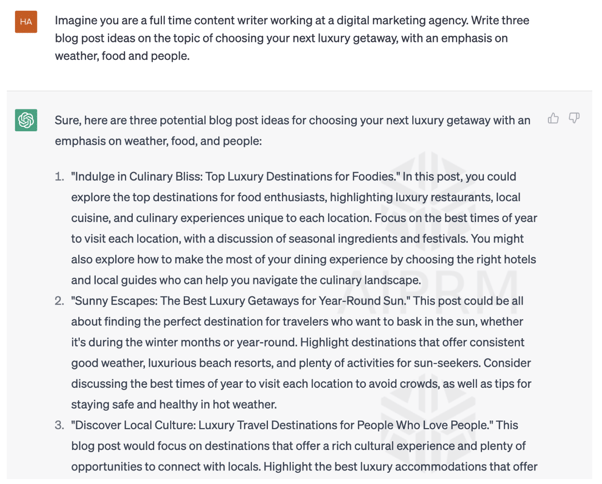
Not bad, but it could be better. Let’s add a little more to it.
To get more advanced with your prompts, we’re going to move on to the next part of the framework — adding classifiers. You don’t have to add all of these, just the ones that make sense for your prompt.
Classifiers:
- Scopes — The range to perform
- Format — Such as using HTML or markdown
- Audience — For example, you’re targeting marketing managers
- Time — Adding a specific time period, such as the year 2020
- Constraints — Such as character length
We’ll use the same example as above to see it in practice.
“Imagine you're a full-time content writer working at a digital marketing agency. Write two blog post ideas on the topic of choosing your next luxury getaway, with an emphasis on weather, food and people. Write it in markdown table format with a column explaining your reasoning. The blog should target Canadian holiday goers at the consideration stage. Each title shouldn't exceed 20 words.”
Result:
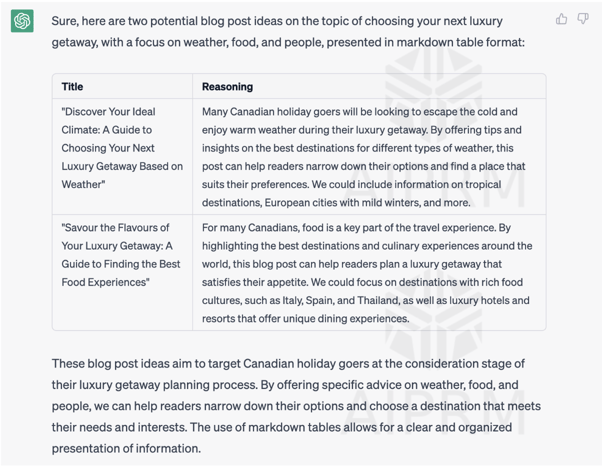
Impressive. This framework can produce the desired results, no matter what context. The (blue) sky is the limit when you learn to communicate effectively with AI.
AI prompts in different marketing roles
Curious to see how else you can apply this framework?
I asked members of our marketing team how they’re using AI in their roles. Here are some standouts that used AI in unique ways.
Design & Development
Graphic Designer, Bilal Padia, shares his favourite use of AI thus far:
“We had a case where the client needed a specific functionality on a drag-and-drop question field. With the help of ChatGPT, I could ask for HTML and CSS code as well as Jquery. I then copied the code into CodePen to see the results and field-tested it. This ensured the development team had a starting point and saved them hours of work researching and writing code.”
The prompt he used was simple at first, but then Bilal used prompt-building skills to achieve his final result.
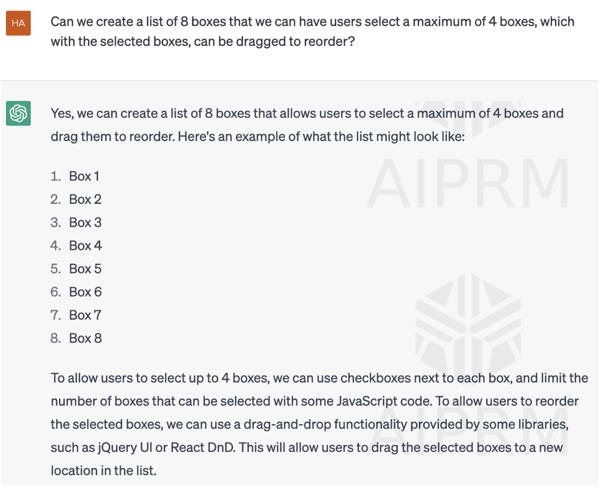
Bilal then asked AI to create the code, which he received and placed into CodePen — an online code editor.
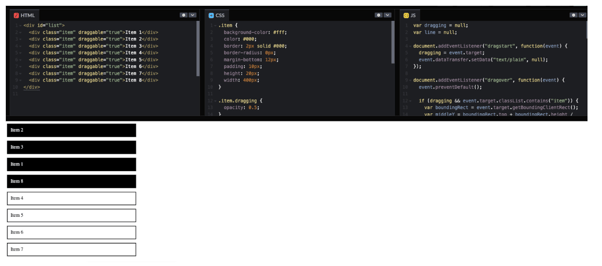
PPC
PPC Specialist, Peter Fletcher, uses ChatGPT to translate keywords into four different languages.
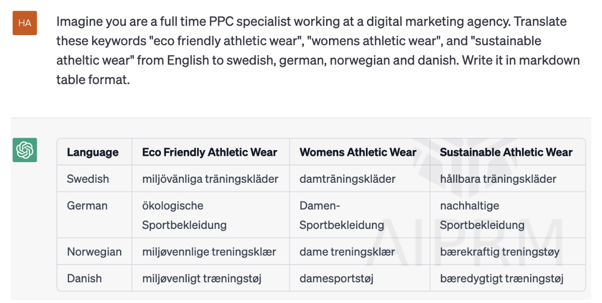
Content
I use AI every day in my role as a Content Specialist at Avidly. However, content is an area where you can’t rely solely on AI to “do the work for you”. It’s an excellent tool to reduce research time and provide inspiration.
I’m going to use writing an Instagram caption as an example. Although I’m not a Social Media Specialist, it’s a fun (and short) example!
Let’s use our tried and tested framework to get some inspiration:
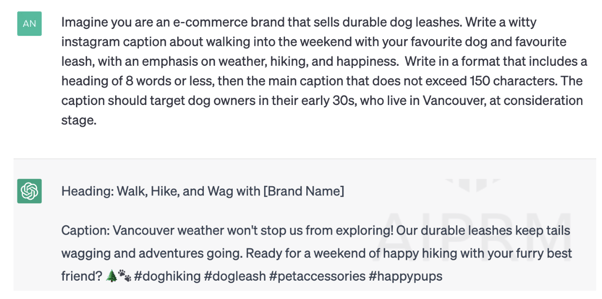
I do like the results but I think it could use some tweaking. Using my human skills, I ended up with this as the final result:

To recap
We all have to learn strong and effective communication at some point in life. But who knew we’d be learning how to communicate with robots?
Learning how to write effective AI prompts that yield the results takes practice. With this helpful framework, we cut down a lot of the trial and error for you. If you stick to this framework, the possibilities are truly endless.
So, get out there and practise!
Want to find out how we can support you?
Real Growth. Real Impact.
AI and HubSpot: Transformation... If Enabled Properly
Unlocking the Power of HubSpot's INBOUND 25 AI for Your Business
Four AI Lessons Avidly's CEO Shared with HubSpot
Interviewing an AI version of HubSpot's founder was weird
How to use HubSpot AI Content Tools - Avidly Sessions video training
How is AI disturbing Google search results and what can you do about it
See why enterprises choose Avidly
Let’s build your HubSpot success story
Compelling final call to action - with accompanying link to Contact page








